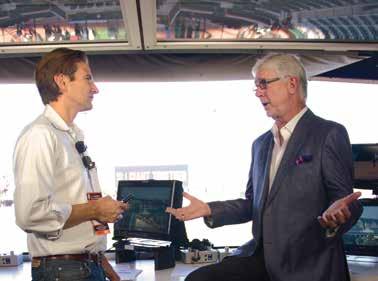
3 minute read
PUBLISHER’S MESSAGE
Smart Trade
I was a heart broken seven-year-old kid growing up in the San Joaquin Valley the day I sounded out the words one-by-one in the headline appearing on the Visalia Times-Delta sports page explaining that beloved San Francisco Giants second basemen Joe Morgan was being traded to the Philadelphia Phillies for some no-name pitcher… a guy named Mike Krukow.
When he first took the mound, I looked for—and found—every reason to not like Krukow. Each time he walked a batter I became more and more convinced that he was, in fact, a good-for-nothin’ bum. While Joe Morgan and the Phillies were stacked with an all-star cast who were laughing their way toward winning the National League pennant, the Giants were aimlessly struggling to get out of last place.
But, it’s almost never statistics that win the hearts and minds of baseball fans; it’s usually the small stuff that is mostly imperceptible to those who do not follow the game. The way a ballplayer wears his pants, chews his gums, or prepares for an at-bat carry as much weight as a slugging percentage or an earned run average. The more I watched “Kruk” handle his business on the mound, the more I liked him.
The following season, I talked my parents into buying me a TV to catch the Giants broadcast out of Fresno. While they were adamantly opposed to the idea, I eventually wore them down like a long-reliever chewing up scoreless innings. For my birthday that year, which always falls right around opening day, I received a brand new twelve-inch black and white boob tube. The gift came with heavy restrictions, however: no more than an hour a day and absolutely no viewing after bedtime. “Okay, sure—no problem,” I said with fingers crossed behind my back.
I found the perfect spot in my bedroom where the set’s rabbit ears picked up everything KMPH was sending southward through the Valley. Before the game started each night, I would spread out the baseball cards of all the starting players. After studying their statistics and analyzing the match-ups, I invariably drew a familiar conclusion: Yep, the Giants are going to win! So, I would watch for an hour, usually getting me to the third inning or so, brush my teeth, say “goodnight” to the family and tuck myself in with my head spinning, wondering if the runner had been stranded on third. After tossing and turning for a while, I would tip-toe across my room and carefully click on the TV to catch the last few innings. I don’t think my parents ever caught on, and if they did, they never said anything—it was usually still too hot to sleep at that hour in our old, un-airconditioned house anyway.
Krukow, who was a standout at Cal Poly, has been a constant in my life since those magical endless summers thirty years ago. Following the trade he settled in San Luis Obispo where he and his high school sweetheart raised five children. It was shortly after his career as a pitcher ended that Kruk returned to the Giants as a broadcaster. Most nights, as we tune into MLB.tv to catch the Bay Area broadcast, it is surreal to see my kids, who are now ten, nine, and five-years-old, watching Kruk call the game. And, it was certainly a thrill to have the opportunity to recently interview him for our story in this issue [see “Mike Krukow Reflects” on page 58]. I felt like a kid again as I peppered the former 20-game winner with questions like, “Who were the toughest guys to get out?” (his answer: Tony Gwenn and Pete Rose); but mostly I marveled at the brilliance of trading away Joe Morgan.
I would like to take this opportunity to say “thank you” to everyone who had a hand in producing this issue of SLO LIFE Magazine and, most of all, to our advertisers and subscribers—we couldn’t do it without you.
Live the SLO Life!










